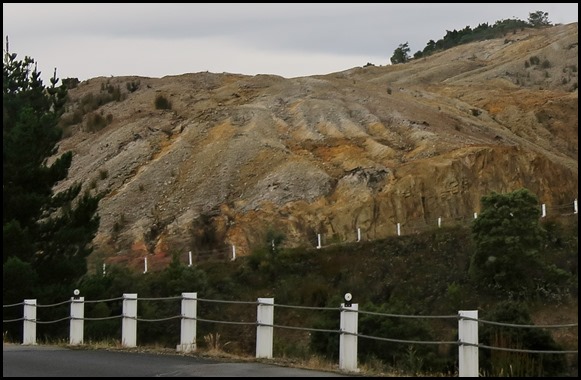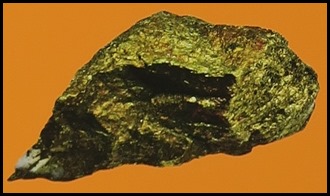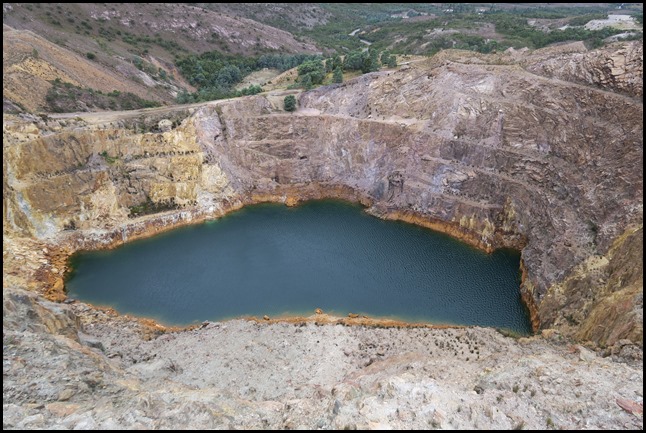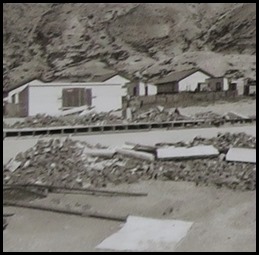Riches and Beauty

Beez Neez now Chy Whella
Big Bear and Pepe Millard
Sat 30 Jan 2016 23:27
|
A Land of Riches and Beauty –
the Mines
 Mount
Heemskirk, north of Zeehan. Both names are taken from Tasman’s two
ships.
In November 1642, only two days out
from Tasmania’s West Coast, Abel Janszoon Tasman wrote in his journal that his
compasses were not working as they should, he then noted, “There might be mines
of loadstone about here”.
Coincidental or not,
Abel Tasman’s supposition proved to be true. Two days later his crew sighted the
mountains of Tasmania’s West Coast. Two hundred and fifty years later, following
the discovery of enormous lodes of tin at Mount Bischoff, the slopes of Mount
Heemskirk were discovered to be black magnetite, nearly sixty six per cent iron.
The surrounding region became famous for a spectacular number of mining booms
from Mount Bischoff in the north to Mount Lyell in the south. Prospectors came
from all over the world in the hope of finding an El Dorado. While the gold in
any large quantity proved elusive, they discovered enormous quantities of tin,
copper, silver, lead, iron and rare minerals such as osmiridium.
 Few regions in the world have been
blessed with so much mineral wealth in such a small area, surrounded by
magnificent scenery. In 1923, local writer and mountaineer Charles Whitham wrote
a small book to promote Western Tasmania to tourists. He included chapters on
the region’s minerals, geology, history, flora, fauna and topography. He called
it “A Land of Riches and Beauty”. The title refers to much more than minerals
and scenic views. Whitham begins his book with a reference to deeper riches, the
food for the soul. He describes the vistas of the
mountains, the valleys, the forests and the deep, dark rivers. And then, quoting
the poet William Wordsworth he writes “There is no doubt that we see with the
soul and not the eyes.....”
   We left Queenstown and climbed the steep road to
the Queenstown Lookout, the colours of the rocks were quite
something. After enjoying the view we settled to reading the information
boards, learning about mining in the area.
The Iron Blow: In January 1883, while following mountain creeks upstream in the
search for reef gold, the McDonough brothers and ‘Steve’ Karlson camped on the
brow of the high ridge between Mount Owen and Mount Lyell. They noticed a large
outcrop of gossan – the kind of oxidised rock formation prospectors look for as
an indication of rich mineralisation below the surface. They called it “Iron
Blow”.
The blow jutted high above the
surface. Strewn down the mountainside were large iron boulders as if there had
once been a massive explosion from deep below the earth’s
crust. The prospectors found some gold in
the creeks below, but initial attempts at mining ‘The Blow’ proved
futile.
Throughout the mis 1880’s the mine
struggled as the McDonough’s and Karlson slowly carved away the gossan outcrop,
convinced that reef gold lay beneath. In 1888 a new company was formed, issuing
new shares and the amount of gold recovered increased, the costs of running the
stamper and freighting the gold to the nearest port at Strahan rendered the mine
unprofitable. Despite the rich potential of ‘The Blow’, in 1890 the directors
decided to wind the company up.
 Lyell
leases during the boom.
  Miners
gathered at the entrance of the tunnel to the silver mine, Mt Lyell 1894. The first furnace in 1896. In the foreground is the town of
Penghana before it was destroyed by bushfire.
In 1888 prospectors and investors
flocked to nearby Zeehan, brought by the discovery of the rich silver deposits.
Hearing of ‘The Blow’ at Mount Lyell, two visiting directors of the Broken Hill
Proprietary Company commissioned a geological report and assays of the ore which
revealed not just gold, but enormous quantities of cooper. They snapped it
up.
The new mine owners needed finance to
construct smelters and a railway to the coast – just as the stock market fell
into a deep depression. In 1891, the frenzy of speculation that followed the
discovery of silver culminated in the collapse of the Van Diemen’s Land Bank
followed by a number of banks in Melbourne. Fortuitously however, Mount Lyell
struck an astoundingly rich vein and smelted – keeping the copper mine
alive.
  All the furnaces
working at full blast in 1899. Interior of one of the
furnaces.
By 1896, the investment climate had
recovered. The company was able to raise enough finance to complete its
ambitious building program. In June that year, the first two smelters were lit.
Four months later it was reported in the London press that ten furnaces would
produce an annual profit of nearly eight hundred thousand pounds. Mount Lyell
was touted as the greatest copper mine in the world.
Queenstown became a hotbed of
prospectors, investors and swindlers. The Tasmanian press called it
‘Copperopolis’ – the copper city.
‘Copper’ and ‘Mount Lyell’ became
magic words, Prospectuses of the new companies that sprang into existence all
stressed their proximity to the ‘mother lode’ at My Lyell and all of them used
the word ‘Lyell’ in their name. In the rush even
geographical proximity to the famous Iron Blow was deemed unnecessary. Mines
appeared as far away as Strahan and Dundas carrying the ‘Lyell’
name.
 The
landscape.
If we had been standing here a
hundred years ago, the entire landscape around us would have been entirely
denuded. The image of billowing smokestacks was a symbol of pride, progress and
‘getting ahead’. It was even reproduced as a picture postcard.
The smoke however, was a toxic gas –
sulphur dioxide. It clogged the air and left the surrounding landscape covered
in poisonous yellow dust. It even changed the local climate.
In still weather a pea-soup blanket
of yellow fog could be seen from Strahan. Here, in the valley, workers would
carry hurricane lamps to get them to and from work in daylight hours.
There were frequent reports of the pungent fog causing workhorses to bleed from
their noses.
While the surrounding forests were
cut down as supplementary fuel for the smelters, what remained was killed by the
sulphur. Within a few years the slopes of Mount Owen, Mount Lyell and all the
surrounding hills were devoid of any vegetation. With Queenstown’s high annual
rainfall, the shallow topsoil was quickly eroded leaving bare rock.
By 1921 the pyritic smelting process
had been superseded by new flotation technologies. The furnaces were gradually
replaced.
The bare hills became a magnet for
artists seeking to capture the pink and yellow hues of the mountain range. There
were even rumours of local anxiety over losing this man-made ‘attraction’. Slow
regrowth has taken hold in many of the valleys but with no topsoil on the higher
slopes it is clear that large areas of the mountain slopes and the surrounding
hills will remain bare rock for generations to come.
 Copper
pyrites [from the Greek ’pyrites lithos’ meaning “stone of fire” –
flint.
The worthless fool’s gold that the
first prospectors found in this area was pyrites – iron sulphide. It is
worthless for a gold digger but of great value to a metallurgist. From ancient
times the incendiary nature of the element sulphur was well known. In
the Bible it is called brimstone – meaning ’burn stone’. As the science of metallurgy developed in the late 1800’s the
common presence of pyrites in many ore bodies generated world-wide interest in
using it as a ready-made fuel for smelting. For the mine at Mount Lyell,
situated in a remote location far from its markets and supplies of coke, the
potential for the process to increase the viability of the mine was
immense.
 Robert
Sticht in his library in Penghana.
The key to Mount Lyell’s success was
a process called pyritic smelting. Rather than importing expensive coke to fuel
the furnaces, the process utilised the heat generated by the combustion of
sulphur in the pyrite.
The Company had approached Robert
Sticht, a world authority in pyritic smelting. Sticht’s first pyritic smelter in
Montana was a failure, but spurred on by the experience, he continued to
experiment. When the Mount Lyell Company approached him in 1883, samples of ore
convinced him the Tasmanian mine would make pyritic smelting an unqualified
success.
It did. When Sticht lit the furnace
on the night of the 25th of June 1896 and tapped the furnace for molten copper,
the workmen could hardly keep up with the flow. The company’s share price
skyrocketed. Sticht was appointed mine manager on a princely income of five
thousand pounds per year.
He left twenty five years later a
very wealthy man. However, the legacy of a quarter of a century of pyritic
smelting can still be seen all around us.
  People anxiously
waiting for survivors to emerge. People reading the
newspapers to learn of loved ones, friends and workmates.
Often shrouded in mist and rain, the
raw beauty of the mountains surrounding this valley hides a tragedy that shocked
the nation. On Saturday the 12th of October 1912 a fire broke out in the Mount
Lyell mine at the seven hundred feet level, trapping men there and in the levels
below. Initially there was little urgency.
The timber supports throughout the
mine were waterlogged beams of King Billy pine – and widely believed to be
fireproof. By late afternoon seventy three men had made their way to safety. It
was then realised slow burning fire was smouldering in the timbers and producing
a small amount of smoke but large amounts of deadly carbon dioxide. Over the
next two days a number of heroic rescue attempts were made. Bodies were found at
the seven hundred feet level and hope was fading for the other men when a
message was received from a signal gong attached to a rope that had been lowered
to the thousand feet level.
 A note found from
one of the men at level seven hundred.
“Forty men in forty stope. Send food
and candles at once. No time to lose. J. Ryan”.
The forty men had survived on the
compressed air nozzles that fed the diamond drills. In record time, fire
fighting and rescue equipment had been sent from Ballarat. On Wednesday, five
days after their entombment, the first forty survivors in forty stope [a
step-like working in a mine] reached the surface. Forty three men including some
of the rescuers, were not so lucky.
 A funeral
train carries rows of coffins as photographers watch from their vantage
point.
Why the fire started remains
controversial. The inquest was inconclusive. While noting circumstantial
evidence suggesting the fire had been deliberately lit by a disgruntled worker
whose brother had been killed in a rockfall, no-one was ever charged. Although
there were allegations of negligence, the Company was exonerated. After inquiry,
the investigating Commissioner was employed by the Company.
Writing forty years after the event,
in The Peaks of Lyell, historian Geoffrey Blainey suggests that the
rise of trade unionism on the west coast, and the lack of preparedness for such
disasters by mining companies at the time contributed to the tragedy. An
alternative view is provided by Peter Schulze in An Engineer Speaks of
Lyell who argues that the most likely cause of the disaster was an
electrical fault.
  Our next stop was at the amazing Iron Blow Lookout.
 The view from the
end of the platform.
 Straight to the information boards.
 Causing a stir. “........this
mine will prove one of the world’s wonders, and the holder of a hundred shares
can consider he is provided with a moderate income for life.” – Australian
Mining Standard, July 1897.
Mining riches or inspiring place?.
Powerful forces beyond our wildest imaginings have conspired to produce the
copper, gold and silver riches of Mount Lyell – along
with ruggedly beautiful terrain that can leave us awestruck.
The landscape we see here may have
been carved by miners during more than a century but first it took nature
millions of years to create it. Minerals were formed within a volcanic island
about 550 million years ago. Hot geothermal springs concentrated them within
young volcanic rocks.
Rocks were buried by sediments in a
shallow sea that protected them from erosion. This landscape was then subjected
to the upheaval of intense heat and pressure, hardening and contorting the rock
layers. The nearby mountain peaks of Lyell and Owen – and others in the Coast
Range – are the remains of sediments.
 Fair worksite or living
hell?
The Mount Lyell Mining and Railway
Company came to be known for a groundbreaking employee welfare scheme. However,
voices from the past show that – just like today – opinions on a workplace are
often a matter of perspective.
Bricklayers petition for a wage rise,
1895. “We beg to state that nothing of any arbitrary or dictatorial spirit
is intended but simply an honest and honourable appeal to you for a wage
commensurate with our toil, intelligence and climate. Whatever determination you
may arrive at, we are sure it will be on a fair and equitable basis, and to
which you may rely we will cheerfully and without prejudice,
abide.”
Article by militant worker in the
Communist newspaper, The Workers Weekly 1930: “We
have to work out in the weather with no provisions made for the wet, either that
or take the sack. The slaves underground and on the smelters on afternoon shift
get the same pay..... The class of bonehead that stays here has nothing on the
brain but the job.... There is no accommodation excepts the pubs. Boarding
houses are very scarce. There are not many unemployed and I would not advise
anyone to come here as the company’s motto is to ‘weld the weak and test the
strong’.”
Though hemmed in by mountains,
Queenstown stays in touch with the rest of the world through modern roads and
communications – but in the early years, it was a long way from
anywhere.
  Behind us the
ore-rich rocks showed many colours.
 In front of us, the scarred landscape.
 Excerpt from 1922 program for Back to
Gormanston celebrations: “Twenty-five years ago,
when the tent-dwellers in the Queen Valley [later Queenstown] were all dressed
up, they had no other place than Gormanston to go if they wanted a legal drink,
a postage stamp or a shirt..... they had to hop over the hill and satisfy their
wants at Lyell, as Gormanston was then known.”
The settlement in the distance is
Gormanston. It is living proof that our destiny can unravel in an instant. Known
locally as ‘Gormie’, it is one of a string of local towns created in mud,
forests, valleys and mountains, only to be destroyed by human
weakness.
They were the product of a bitter
feud between two mining men and their rival companies. The men, James Crotty and
Bowes Kelly, had by the end of the 1880’s each built their own major mine,
smelters, railway, port and series of towns, housing a total of 10,000
people.
Crotty had the richest mine, North
Lyell, which suffered from poor management and financial blunders. Kelly’s Mount
Lyell Mining Company had astute leadership but diminished ore reserves. A merger
was inevitable. Locals waited nervously to see which railway, port and towns
would die. The agreement was signed in 1903 and went against the North Lyell
Company.
 Gormanston State
School, destroyed in a storm, 1950’s.
 The town of Darwin, south of here,
was abandoned overnight, Crotty was soon deserted – its site is now below
man-made Lake Burbury. Pillinger, at Kelly Basin, with brand new wharves,
houses, shops and brickwork lingered for a
few years. Linda, sister town to
Gormanston, [Linda Post Office opened on the 18th of December 1899 and closed in
1966] is a ghost town, later we would drive past the ruins of the Royal Hotel in the Linda Valley. Gormanston despite
much adversity, has managed to survive with a
permanent population of 167 [2006 census]. New recreation opportunities rather
than mining are now the life blood of the communities. Queenstown became the
area’s main town and Strahan its port. But it could just as easily have been
Gormanston or Pillinger.
 The rock at the
Lookout, the plaque reads: The Mount Lyell
Mine “The Iron Blow”.
This ground was first pegged by
Mick and Bill Macdonough and Steve Karlson in November 1883 in their search for
gold. The lease was worked for gold with limited success until it was recognised
as a copper mine and bought by Bowes Kelly and William Orr in 1891. In March 1893 they formed the Mount Lyell Mining and Railway
Company Limited. A lucky bonanza of high grade silver ore was a major factor in
financing Mount Lyell while the copper smelter and the railway to Strahan were
built. From 1893 to 1895, 849 ton of ore was sold assaying 21% copper and 1023
oz. of silver per ton. Subsequently the Blow was worked until 1929 and yielded
5. 497,468 ton of ore assaying 12% copper , 2 oz. silver per ton and 0.0065 oz.
gold per ton.
Commemorating the Lyell District
Centenary November 1983.
 ALL IN ALL QUITE A
STORY
FASCINATING HISTORY
|